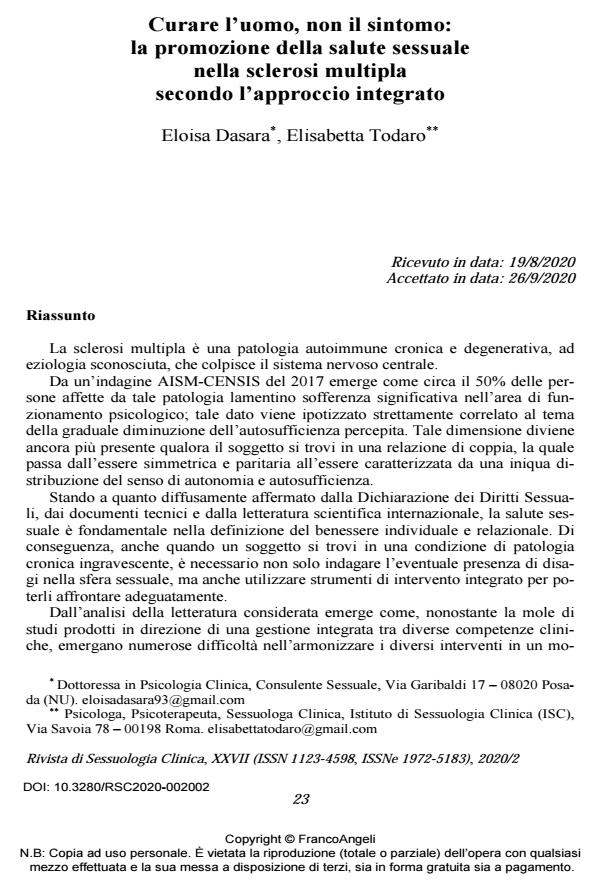Taking care of the man, not the symptom: the promotion of sexual health in multiple sclerosis according to an integrated approach
Journal title RIVISTA DI SESSUOLOGIA CLINICA
Author/s Eloisa Dasara, Elisabetta Todaro
Publishing Year 2020 Issue 2020/2
Language Italian Pages 23 P. 23-45 File size 255 KB
DOI 10.3280/RSC2020-002002
DOI is like a bar code for intellectual property: to have more infomation
click here
Below, you can see the article first page
If you want to buy this article in PDF format, you can do it, following the instructions to buy download credits

FrancoAngeli is member of Publishers International Linking Association, Inc (PILA), a not-for-profit association which run the CrossRef service enabling links to and from online scholarly content.
Multiple sclerosis is a chronic and degenerative autoimmune disease of unknown etiology that affects the central nervous system. It is generally diagnosed between 20-40 years old and currently affects about 118,000 people in Italy, with an esti-mated 3,400 new cases a year; it has a double prevalence in women than in men. From a 2017 AISM-CENSIS survey, emerges that about 50% of people affected by this pathology complain psychological difficulties; this data can be explained with the gradual decrease in self-autonomy, with consequences in the quality of life and in relational functioning. This dimension becomes even more present in a couple relationship, which starts equal to become unequal and asymmetric. This aspect, concerning different areas of the couple’s dynamics, inevitably affects sexuality too. According to what is widely stated in the Declaration of Sexual Rights and in international scientific literature, sexual health is fundamental for the quality of personal and couple life. Consequently, it is necessary not only to investigate the possible presence of discomfort in the sexual response, but also to use integrated tools to be able to deal with it. The prevalence of sexual dysfunctions in patients with multiple sclerosis suggests the need to take care of the patient, including the investigation of sexuality. The presence of sexual dysfunctions was highlighted in men in the range of 50-73% of cases, and in women up to 82.5% of cases. These data are significantly higher than those of the general population. In the introduc-tion of the present work, is presented the clinical definition of multiple sclerosis, underlining how it manifests and investigating its epidemiological aspect. After-wards, different studies are discussed relating to the presence of sexual dysfunc-tions in multiple sclerosis and highlighting the consideration of multiple etiology. In fact, sexual dysfunctions in multiple sclerosis can be linked to different causes, such as the presence of lesions in the higher centers, which interrupt the variation and integration of stimuli able to activate and support the sexual response; injuries to the spinal cord and peripheral nerves and injuries to the hypogastric nerves. An-other important role in the development of sexual dysfunction in people with multiple sclerosis is related to alterations in hormone secretions. Multiple sclerosis lesions can affect the hypothalamus and the fibers that origi-nate from it, thus interfering with the hypothalamus-pituitary-gonadal axis. In ad-dition, the reduction in circulating testosterone levels is demonstrated in subjects with multiple sclerosis, both male and female. On the contrary, regular sexual ac-tivity increasing the circulating levels of testosterone and estriol, has neuroprotec-tive and anti-inflammatory effects, promoting muscle relaxation, facilitating sleep and decreasing depressed mood. For this reason, it is essential to deal with the evaluation and treatment of sexual dysfunctions, in order to restore a virtuous health circuit, following the bio-psycho-social model. Regarding treatment, sexual counseling is generally aimed at the evaluation of symptoms. From the literature considered, it emerges that, despite the amount of studies suggesting an integrated management between different medical skills, various difficulties emerge in har-monizing the various interventions in an integrated model of care. It is hypothe-sized that this scenario is a consequence of the split, still existing today in the treatment of chronic diseases, in the considering "body" or "psyche" with the lack of taking care of patients in their complexity. A chance towards integration comes from the integrated approach in Clinical Sexology. In conclusion, to provide a use-ful guideline for investigating of the patient’s sexuality, an example of an integrat-ed approach is presented through the PLISSIT model.
Keywords: Chronic disease, multiple sclerosis, sexual health, sexual rights, integrat-ed approach, bio-psycho-social model
Eloisa Dasara, Elisabetta Todaro, Curare l’uomo, non il sintomo: la promozione della salute sessuale nella sclerosi multipla secondo l’approccio integrato in "RIVISTA DI SESSUOLOGIA CLINICA" 2/2020, pp 23-45, DOI: 10.3280/RSC2020-002002